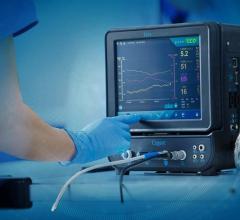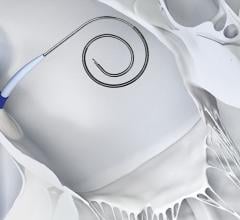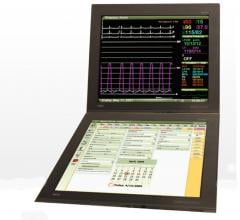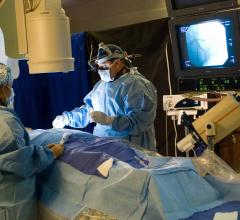
Beyond measuring blood flow, pressure, oxygen levels and other vital signs in the cardiac catheterization lab, current hemodynamic recording systems are an integral part of clinical reporting. Hemodynamic data from newer systems helps auto-completion of data fields in procedure reports, can automate gathering registry data, and can help interface cath lab patient data with the patient’s electronic medical record (EMR).
In the cath lab, the hemodynamic system is at the core of all procedures, including cardiac procedures, interventional radiology, vascular surgery and electrophysiology (EP). Newer-generation hemodynamic monitoring systems have interfaces to help document all types of procedures. This may include charting, device usage, specific site identification, fractional flow reserve (FFR), sheath exchanges, and automatic timers to record balloon inflation time and pressures applied. The data gathered by the system helps speed workflow by automatically generating reports and auto-fills report fields and billing information. Interfaces also display and record waveforms. Many features of these systems can be customized to each cath lab’s needs. Most also contain a coronary tree diagram for procedure documentation.
Watch a video from ACC.16 explaining trends in technology and new hemodynamic systems
CVIS-Hemodynamic Integration
Two key requirements for today’s cardiovascular information systems (CVIS) are solid integrations with both enterprise-wide EMR systems and the cath lab’s hemodynamic monitoring system. Both will enable increased efficiency, faster workflows and the ability to meet data integration requirements mandated under U.S. healthcare reform in the coming years. Tight integration between the CVIS and the hemodynamic system eliminates the need to manually tabulate or re-enter data that is already stored in an electronic format.
With a good CVIS-hemodynamic system interface, diagnostic cath reports can be completed after a procedure in about five minutes. Interventional reports can be completed within roughly 10-15 minutes, with the hemodynamic measures automatically populating some of the report fields. Automatic transfer of hemodynamic data also helps shorten the manual process of transferring this information into registry reporting templates for the National Cardiovascular Data Registry (NCDR) CathPCI database.
GE Mac-Lab
GE’s Mac-Lab hemodynamic recording system recently added new features and functionality designed to help make the cath lab more productive, remove workflow and data storage obstacles, and enable more procedures per day. These features include streamlined multi-path documentation and reporting, which helps the user document cases with few interruptions. They can now start a report anywhere on the network and document on multiple stations simultaneously. The new Invasive Workbench feature expands recording, enabling scientific research on any previously acquired Mac-Lab dataset. It interfaces directly with MATLAB algorithmic development software and its l suite of signal processing tools and graphics. This makes it possible to develop and apply custom algorithms to analyze signals post-procedure. Users can now sign their case reports electronically and transfer the data immediately to data storage. Once signed, the report is locked from editing, although further signatures can be added. E-signatures may also help improve documentation compliance and reporting workflow.
“I had the opportunity to evaluate the new functionality in the Mac-Lab systems. The new multi-path workflow will give our staff the ability to start a new study at separate workstations in the same room. This will allow documentation to be completed on one workstation while starting a new patient on another. In my opinion, the new workflow has the potential to enable faster room turnover time, potentially leading to improved door-to-balloon time. As we know, this is extremely important in acute patients,” said Gina Heinz, a cath lab manager with Centegra Healthcare in Illinois.
McKesson’s CVIS
McKesson offers its own hemodynamic monitoring solution which provides support for intra-procedure monitoring and charting with integrated FFR as well as pre- and post-procedure patient charting for the holding area. It can be sold as a standalone system that can be interfaced to a CVIS or EMR for reporting, or as is most commonly done, is purchased with the McKesson CVIS solution. The McKesson CVIS and hemo system use the same database, and thus do not require an interface to connect to each other. The McKesson CVIS can also interface to other hemo solutions.
A key difference between CVIS and EMR cardiac reporting modules is a smooth integration with the hemodynamic system. McKesson's integration allows multiple people to chart data on the same patient at the same time; the hemodynamic data is immediately available in the CVIS physician report, instead of requiring a case to be closed and the data transferred after a procedure. The data also auto-populates and completes sections of the cath report as the procedure is in progress.
Merge Hemo
Merge Healthcare’s Merge Cardio system was named Best in KLAS for the cardiology software category in the "2014 Best in KLAS: Software and Services" report. In addition, Merge Hemo was named the KLAS Category Leader in Cardiology Hemodynamics for the fourth consecutive time in 2014. Merge Cardio, implemented in more than 200 hospitals, gives providers the ability to access and manage patients' digital integrated cardiovascular record from a centralized, Web-based system. Merge Hemo automates cath lab processes into an electronic health record to enable efficient workflow, and is currently running in more than 500 cardiac cath labs in some of the country's largest health systems.
In June 2015, Merge announced it has entered into a strategic partnership with Toshiba America Medical Systems so Toshiba can offer its customers a full turnkey cath lab installation solution. Toshiba offers premium X-ray angiography imaging systems for cath labs, but unlike its competitors GE, Philips and Siemens, it does not have its own hemodynamic system to provide a complete one-stop shop for an entire cath lab installation. The hemodynamic system partnership with Merge now provides this.
Philips Xper
Philips Healthcare released its upgraded Xper Flex Cardio Physiomonitoring system in 2012. It is equipped with advanced clinical decision support tools to help evaluate a patient’s overall cardio performance. It displays and analyzes invasive blood pressure, surface electrocardiogram (ECG), respiration and other vital signs. The Xper Flex offers several advantages over previous systems, including traditional 12-lead interpretation of the resting ECG in addition to 16-lead analysis, enabling clinicians the freedom to choose which approach is most appropriate for each situation. The additional right chest and posterior leads used in 16-lead ECGs can provide information that may not be apparent on traditional 12-lead ECGs.
“Implementing Xper Flex Cardio has helped us enhance both the functionality and accuracy of our cath lab,” said Karen Keane, director, cardiac cath labs, Martin Memorial Medical Center, Stuart, Fla. “Its ability to analyze up to 16 leads of simultaneously-acquired ECG waveforms enables us to refine patient care, and its smaller size makes it the perfect system for our high-use, multi-function lab.”
Xper Flex Cardio also comes equipped with integrated FFR functionality — which provides data that could aid in treatment decisions — and a DXL ECG Algorithm analysis capability that uses multiple steps to produce precise and consistent ECG measurements to generate interpretive statements. Additionally, the system has Culprit Artery Detection—a technology that provides suggestions on the probable site of an occlusion prior to cath procedure, saving valuable time and assisting with procedure planning—and patented ST Maps that provide a graphical indication of ST elevation.
Philips acquired Volcano Corp. in early 2015, so Volcano’s FFR, intravascular ultrasound (IVUS) and optical coherence tomography (OCT) technologies now fully integrate into the Xper system. Additionally, Philips has secured strong ties with FFR market leader St. Jude Medical.
Siemens Axiom
The Axiom Sensis XP is the latest generation of Siemens’ recording solution. It adapts to the user's workflow, featuring customizable workflow support programs and advanced measurement functions. The system combines both EP and hemodynamics in one system and communicates with the Siemens Artis zee angiography imaging system. It also interfaces to the Carto XP EP mapping system and the Infinity patient monitoring Gateway, which complement the dataflow and increase the efficiency. Axiom uses an extended HL7 engine and DICOM compatibility to facilitate seamless communication in the lab, the control room and across your enterprise.
Read the 2017 article "Newer Hemodynamic Monitoring Systems Address Need for Integration."
Hemodynamic Monitoring Systems Comparison Chart
This article served as an introduction for a hemodynamic systems comparison chart, which can be accessed on the DAIC website at www.dicardiology.com/content/hemodynamic-monitoring-systems. This page requires registration, which is free and only takes a minute to complete. The chart includes technical specifications for all the major cath lab hemodynamic systems on the U.S. market.
Chart participants include:
GE Healthcare
www.gehealthcare.com
McKesson
www.mckesson.com
Merge Healthcare
www.merge.com
Philips Healthcare
www.healthcare.philips.com
Siemens Healthcare
usa.healthcare.siemens.com
Mennen Medical
www.mennenmedical.com
Scranton Gillette Communications obtained the model specifications
from the manufacturers.



 November 14, 2023
November 14, 2023 





